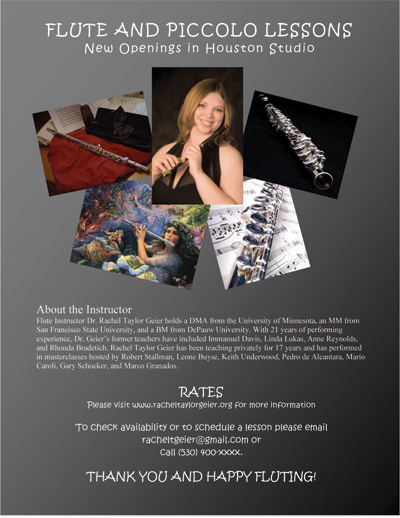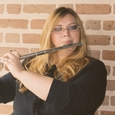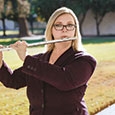
With an unpredictable job market musicians and academics often have to adopt a certain degree of flexibility regarding job location and salary, especially for those with a spouse in a similar situation. Many apply for every teaching or performing job available which can lead to frequent relocation to new cities. Turn lemons into lemonade by learning how to quickly set up, market and recruit students for private studios in new locations across the country. I have moved to seven different cities over the past decade and have successfully taught privately in each location, instructing flute students young and old and building new and lasting relationships within the surrounding communities. It was not always easy but with a little time, a lot of communication and a bit of elbow grease I have transplanted my studio around the country.
Market Yourself
The key to relocating a studio is to apply some practical entrepreneurial techniques and reach out to local teachers, students and parents. When I was graduate student in San Francisco, marketing myself was something that I took for granted and consequently my studio suffered. I focused on the insular life of the university and forgot to take advantage of the resources available in the large surrounding community. It was not until I moved to Walnut Creek, California that I began to make appropriate connections with other teachers, musicians, community bands, and parents. With this renewed effort, my studio regained its pre-graduate school popularity. Many people are uncomfortable marketing themselves, but it is an essential business skill. Start by looking critically at how you present yourself professionally to the outside world. It may help to ask a colleague for an impartial opinion.
Update Your Materials
Once you learn that you are moving to a new location, update your CV. Include the names of groups with which you have performed, conference talks you have presented, awards you have received, and masterclasses you have attended or hosted. Update your website, or set one up if you have not yet done so. Make sure that studio policies, biography, sample recordings, testimonials and any other important links are accurate and easily found. This is part of your overall web presence, and the first place that new contacts will go when performing initial research on you.
Upon moving to Davis, California, I immediately set up a website listing basic biographical information, links to online recordings, studio policies, teaching rates, location, and contact information. Having this information readily available on the internet made it easy for parents in the area to quickly research my qualifications and policies before scheduling lessons.
I created links to my website on the Davis Music Teachers Association website and circulated my URL to a handful of local teachers. Later I added a number of new tabs containing copies of my CV, DMA paper abstract, performance schedule, conference presentations, and a flute blog. Hosting a flute blog has connected me with musicians across the globe and gives parents and students a clear picture of my pedagogical methods and teaching style. I have received many emails of inquiry from parents and students who simply enjoyed my weekly blog and wanted to practice some of the exercises from blog postings in their own flute lessons.
Use Social Media
Create a Twitter account, a LinkedIn account, a Facebook artist page and a YouTube account to further build your internet persona. If you are an academic or hold an advanced graduate degree, set up or update an Academia.edu account. Here you may upload articles you have published, conference paper abstracts, and any other creative projects developed during your graduate career. I receive many new contacts from these mediums and have found Twitter and LinkedIn to be particularly effective marketing resources for my weekly Flute Friday blog posts. The web has made it possible to research a great deal about an artist or a teacher long before you meet them in person. It is therefore crucial that your internet footprint accurately and professionally represent who you are as a teacher, researcher and musician to the outside world before you begin to advertise your services.
 Old Fashioned Networking
Old Fashioned Networking
With your materials updated and a bit of razzle-dazzle applied to your online profile, the next step is some good, old fashioned networking. Email has replaced the standard cold call system of the past, and Google has made it relatively simple to compile a list of email contacts for band and orchestra directors in your future community. Create a simple email of introduction stating your educational background and studio location and request that your contact information be passed on to flute students searching for a private instructor.
Attach a copy of your CV and a lesson flyer to be posted in common areas. I have used basic Microsoft Word templates to create one-page flyers throughout the years and have found that color flyers with interesting photos or graphics, as well as a decent headshot, are most effective. A flyer should contain information about where your studio is located, a short biography listing educational degrees, former applied teachers, any community performing groups with which you perform regularly, contact information and website links. I have experimented by listing lesson rates on the promotional flyer but find it best to keep the flyer simpler and list rates on my website where interested students can gather detailed information before inquiring about lessons.
In the email to the band teachers offer to host an after school woodwind sectional. Many of my students have signed up for lessons after having an opportunity to meet me in person and test drive my teaching style at a group masterclass or flute sectional. I have taught flute sectionals at local high schools for a number of years and find that word-of-mouth recommendations from these students to their friends spread like wildfire. The ensemble director is also a wonderful reference and will likely give your name to other students and directors if they notice a significant improvement in the quality of playing within their flute section. The recommendation of a school band or orchestra teacher can carry a lot of weight.
Connect with the local flute community. These are by far your most important contacts when moving to a new city. Send introductory emails to local flute teachers letting them know that you will be relocating to the area and would love to collaborate with them on any performing or teaching projects. Find out if there is a flute club nearby and become a member. I have created numerous, lasting connections through the Sacramento and Houston Flute Clubs and have recruited several students using their organizational resources and recommendations from other flute club members. Many flute clubs circulate directories of teachers to educational and community organizations to aid students looking for private instructors. Flute clubs also offer valuable opportunities to perform in flute choirs or participate in masterclasses as performers, auditors or as volunteers. The Sacramento Flute Club, for example, hosts a flute choir of local teachers and sponsors masterclasses throughout the year.
If a flute club has not been established, communicate via email with other local flute teachers on plans to create a new organization. The most valuable experiences I have had in recent years have come from the relationships I have developed with other flutists in local flute organizations. This is a critical networking step for your studio but also important to your development as a flutist.
Get on the List
Many larger cities and suburbs host music teacher organizations that connect private instructors to potential students by advertising studio information on websites and distribution lists circulated at local instrument stores and music supply centers. Be sure to add your name to these organizations as they often reach out to students and parents. I received many new students after they saw my listing at a local music store while they were there selecting their first rental instrument.
Research local music stores and circulate email introductions to store managers, again attaching your CV and lesson flyer. Ask whether they offer studio space to local teachers. Giving lessons at a local music store introduces you to the community and provides free advertisement and access to books and supplies for your students. The downside to teaching at a music store is that there will typically be a fee to use the space. Arrange meetings with music store managers to discuss studio rental fees, how often fees are paid, how much flexibility you will have regarding rates (some music stores set their own rates in advance), scheduling, available studio hours, what types of marketing they are able to provide (internet postings, store newsletters, direct referrals), and to which audiences they will advertise (customers, schools, etc.). It may be beneficial to begin your practice in a music store to easily recruit a greater number of younger, beginning students before moving to a home studio location once you are more established as a teacher and performer within the community. Another option is to split your time between a home studio and store lessons.
Offer a Masterclass
Upon arrival in your new city one of the best things to do to increase interest in your studio is to host a free flute masterclass at a central location within the city. Possible venues for masterclasses include schools, churches, and community centers. Develop a simple yet beautiful flyer for the event and circulate it via email to local schools, flute teachers, music stores, youth orchestras, amateur groups including community bands or orchestras, and any local music organizations or clubs. Similar to the studio flyer, this should be a one-page advertisement for the event using bold colors and a nice headshot. List the time, date and location of the masterclass, as well as application and audition instructions. Don’t forget to include a short biography with your email and website information.
The masterclass should contain a healthy balance between one-on-one instruction with soloists and larger group activities that appeal to flutists of all levels of experience. Large group activities could include breathing, articulation and postural demonstrations. At a recent masterclass I hosted at a high school in Houston, I asked students to play a two octave G major scale using a simple too syllable. On the next repetition I asked them to use a coo syllable. On the third a too-coo articulation to introduce the basics of double tonguing. On the next repetition I asked students to play the same scale using the syllables ukta-tuka which further strengthened the backs of their tongues and tut-cut to practice short, staccato articulation. Finally, they played the same G major scale using chirps, or tones created only with the air stream. This is a great exercise to teach students how to practice different styles of articulation using a single scale and how different syllables produce different types of sounds that can be used in a variety of performance scenarios.
I also led students through an improvisation exercise, giving each student an opportunity to improvise over a sustained drone performed by the rest of the group. Much like a drum circle for the flute, students were offered a chance to explore their own creativity. This demonstration is similar to an exercise I lead students through during the final minutes of a typical private flute lesson. Once students have experienced your teaching style, give them an opportunity to ask questions about studio policies and scheduling availability. Be sure to direct interested students to your website and other social media links for more information. Hosting additional free masterclasses at different locations will widen the geographical pool of potential students and increase the likelihood of recommendations throughout the community.
Set up a Calendar
As you begin to schedule new students, create and maintain an accurate studio calendar (such as in Google Calendars), setting up reminders to circulate invoices either at the beginning or end of each month. I like to color code the calendar for each student and add notes about repertoire they are working on, techniques that they may be developing, or outstanding invoice payments. Asking students, “What are you working on?” at the start of each lesson is not very professional and does not lead to lessons that build constructively upon previous lessons. Have the calendar handy at each lesson to iron out scheduling conflicts. Your students and their parents will appreciate attention to organization, and you will run a much more efficient business. These small but important considerations have helped keep my studio running smoothly over the years despite the often crazy schedules of my students.
Skype Lessons
When you move, you do not have to abandon former students. Skype lessons have gained popularity in recent years and allow teachers to connect to students all over the globe. Offer a special discount for Skype lessons and devote two evenings or so per week to students learning at a distance. I post a schedule on my website and update it as new students commit to Skype lessons. Assignments may be emailed as PDF attachments and links to new music and supplies can be included in the body of the email. Skype students may also participate as auditors at studio masterclasses using a multi-participant connection on a computer positioned facing the stage. Many of my students who have moved overseas have stayed connected via Skype lessons.
When teaching with Skype, make sure students have a decent microphone. Lapel microphones are fine, but condenser microphones connected to a laptop using a USB chord provide a better sound quality in the higher register. If students live in a different time zone, make sure that you calculate the lesson time correctly and give them the schedule based on their own time zones. Ensure that the internet connection on both sides is sufficient. A poor internet connection can eat away precious minutes or even end the lesson prematurely. Proper lighting is also important. They should position a light to shine on them and not the camera. The camera should also be positioned far enough away for you to get a good view of their overall posture and hand position. This will make it easy to note postural problems and correct faulty fingerings or movements of the arms or feet. Skype is a wonderful resource for teachers and allows us to truly create mobile studios.
Students’ Priorities
Student, parent and teacher priorities vary widely from one location to the next. In one California community, I discoverd that students devoted much of their practice time to successfully auditioning for one of the four regional youth orchestra programs. In our lessons students focused on learning scales from memory, selecting and polishing audition repertoire, and hosting several mock auditions to work on audition skills and performance anxiety. In Texas, however, students in band programs across the state audition for placement in honor and regional bands and are assigned a series of three required pieces or etudes to learn during the fall semester.
Meet with students and teachers in the new community and research the dates and audition requirements for local honor bands, solo and ensemble contests, youth orchestras and any music festivals students may compete in for experience, scholarships or other prizes. Check the performance schedules of school programs to avoid conflicts with studio events. Develop goals with your students and adapt your teaching approach to help your students attain their goals.
Pitfalls
A misconception I held throughout my early experiences moving from place to place was that there would be students simply waiting for me when I arrived in my new town. Before I moved to Davis, I was told that there were numerous students in the surrounding cities constantly searching for a teacher and that I would have no trouble setting up a full studio upon my arrival. What I did not realize was that the high school and middle school music programs already had flute teachers on staff and finding students who were not already taking lessons was rather difficult. I also assumed that filling my day with students would be easy and that there was no need to seek outside employment. Wrong and wrong. Building a successful studio takes time, patience and hard work. You may need a part-time job outside of music until your studio gains popularity. It may take a few weeks or months to build your empire! In the meantime, stick with it. Join local performing groups, attend recitals, and connect with flute teachers. Every little bit helps establish you within the musical community of your new town.






